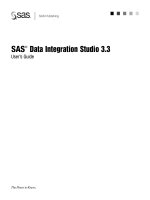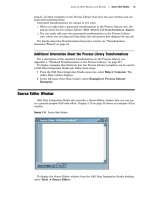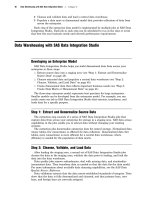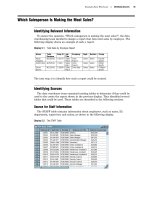SAS Data Integration Studio 3.3- P1 docx
Bạn đang xem bản rút gọn của tài liệu. Xem và tải ngay bản đầy đủ của tài liệu tại đây (552.93 KB, 5 trang )
SAS
®
Data Integration Studio 3.3
User’s Guide
The correct bibliographic citation for this manual is as follows: SAS Institute Inc. 2006.
SAS
®
Data Integration Studio 3.3: User’s Guide. Cary, NC: SAS Institute Inc.
SAS
®
Data Integration Studio 3.3: User’s Guide
Copyright © 2006, SAS Institute Inc., Cary, NC, USA
ISBN-13: 978-1-59047-869-1
ISBN-10: 1-59047-869-X
All rights reserved. Produced in the United States of America.
For a hard-copy book: No part of this publication may be reproduced, stored in a
retrieval system, or transmitted, in any form or by any means, electronic, mechanical,
photocopying, or otherwise, without the prior written permission of the publisher, SAS
Institute Inc.
For a Web download or e-book: Your use of this publication shall be governed by the
terms established by the vendor at the time you acquire this publication.
U.S. Government Restricted Rights Notice. Use, duplication, or disclosure of this
software and related documentation by the U.S. government is subject to the Agreement
with SAS Institute and the restrictions set forth in FAR 52.227-19 Commercial Computer
Software-Restricted Rights (June 1987).
SAS Institute Inc., SAS Campus Drive, Cary, North Carolina 27513.
1st printing, March 2006
SAS Publishing provides a complete selection of books and electronic products to help
customers use SAS software to its fullest potential. For more information about our
e-books, e-learning products, CDs, and hard-copy books, visit the SAS Publishing Web site
at support.sas.com/pubs or call 1-800-727-3228.
SAS
®
and all other SAS Institute Inc. product or service names are registered trademarks
or trademarks of SAS Institute Inc. in the USA and other countries.
®
indicates USA
registration.
Other brand and product names are registered trademarks or trademarks of their
respective companies.
Contents
PART1 Introduction 1
Chapter 1
Using This Manual 3
Purpose of This Manual 3
Intended Audience for This Manual
3
Quick Start with SAS Data Integration Studio
4
SAS Data Integration Studio Online Help
4
Chapter 2
Introduction to SAS Data Integration Studio 5
The SAS Intelligence Platform
5
What Is SAS Data Integration Studio?
6
Important Concepts
6
Features of SAS Data Integration Studio
9
Chapter 3
About the Main Windows and Wizards 11
Overview of the Main Windows
12
About the Desktop
13
Expression Builder Window
16
Job Properties Window
17
Open a Metadata Profile Window
17
Options Window
19
Process Designer Window
20
Process Library
23
Source Editor Window
25
Table or External File Properties Window
26
Transformation Properties Window
27
View Data Window
27
Overview of the Main Wizards
29
New Job Wizard
32
Transformation Generator Wizard 34
PART
2 Planning, Installation, and Setup 37
Chapter 4
Designing a Data Warehouse 39
Overview of Warehouse Design
39
Data Warehousing with SAS Data Integration Studio 40
Planning a Data Warehouse 41
Planning Security for a Data Warehouse 42
Chapter 5 Example Data Warehouse 43
Overview of Orion Star Sports & Outdoors 43
iv
Asking the Right Questions 44
Which Salesperson Is Making the Most Sales?
45
What Are the Time and Place Dependencies of Product Sales?
49
The Next Step
51
Chapter 6
Main Tasks for Administrators 53
Main Tasks for Installation and Setup
54
Deploying a Job for Scheduling
65
Deploying a Job for Execution on a Remote Host
68
Converting Jobs into Stored Processes
69
Metadata Administration
71
Supporting HTTP or FTP Access to External Files
72
Supporting SAS Data Quality
72
Supporting Metadata Import and Export
72
Supporting Case and Special Characters in Table and Column Names
73
Maintaining Generated Transformations
75
Additional Information About Administrative Tasks
88
PART3 Creating Process Flows 89
Chapter 7
Main Tasks for Users 91
Preliminary Tasks for Users
93
Main Tasks for Creating Process Flows
96
Registering Sources and Targets
97
Importing and Exporting Metadata
98
Working With Jobs
99
Working With SAS Data Quality Software
104
Updating Metadata
105
Viewing Data in Tables, External Files, or Temporary Output Tables
110
Viewing Metadata 111
Working with Change Management
113
Working with Impact Analysis and Reverse Impact Analysis (Data Lineage)
116
Working with OLAP Cubes
116
Additional Information About User Tasks 117
Chapter 8 Registering Data Sources 119
Sources: Inputs to SAS Data Integration Studio Jobs
119
Example: Using a Source Designer to Register SAS Tables
120
Example: Using a Source Designer to Register an External File
126
Next Tasks 138
Chapter 9 Registering Data Targets 139
Targets: Outputs of SAS Data Integration Studio Jobs 139
Example: Using the Target Table Designer to Register SAS Tables 140
Next Tasks 148
v
Chapter 10
Example Process Flows 149
Using Jobs to Create Process Flows 149
Example: Creating a Job That Joins Two Tables and Generates a Report
150
Example: Creating a Data Validation Job
167
Example: Using a Generated Transformation in a Job
174
Chapter 11
Optimizing Process Flows 181
Building Efficient Process Flows
182
Analyzing Process Flow Performance
187
Chapter 12
Using Slowly Changing Dimensions 195
About Slowly Changing Dimensions
195
SCD and SAS Data Integration Studio
198
Example: Using Slowly Changing Dimensions
204
PART4 Appendixes 215
Appendix 1
Standard Transformations in the Process Library 217
About the Process Library
217
Additional Information About Process Library Transformations
221
Appendix 2
Customizing or Replacing Generated Code in SAS Data Integration
Studio 223
Methods of Customizing or Replacing Generated Code
223
Modifying Configuration Files or SAS Start Commands
224
Specifying Options in the Code Generation Tab
225
Adding SAS Code to the Pre and Post Processing Tab
225
Specifying Options for Transformations
225
Replacing the Generated Code for a Transformation with User-Written Code
226
Adding a User-Written Code Transformation to the Process Flow for a Job
227
Adding a Generated Transformation to the Process Library
228
Appendix 3
Recommended Reading 229
Recommended Reading
229
Glossary 231
Index 239









